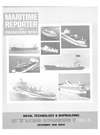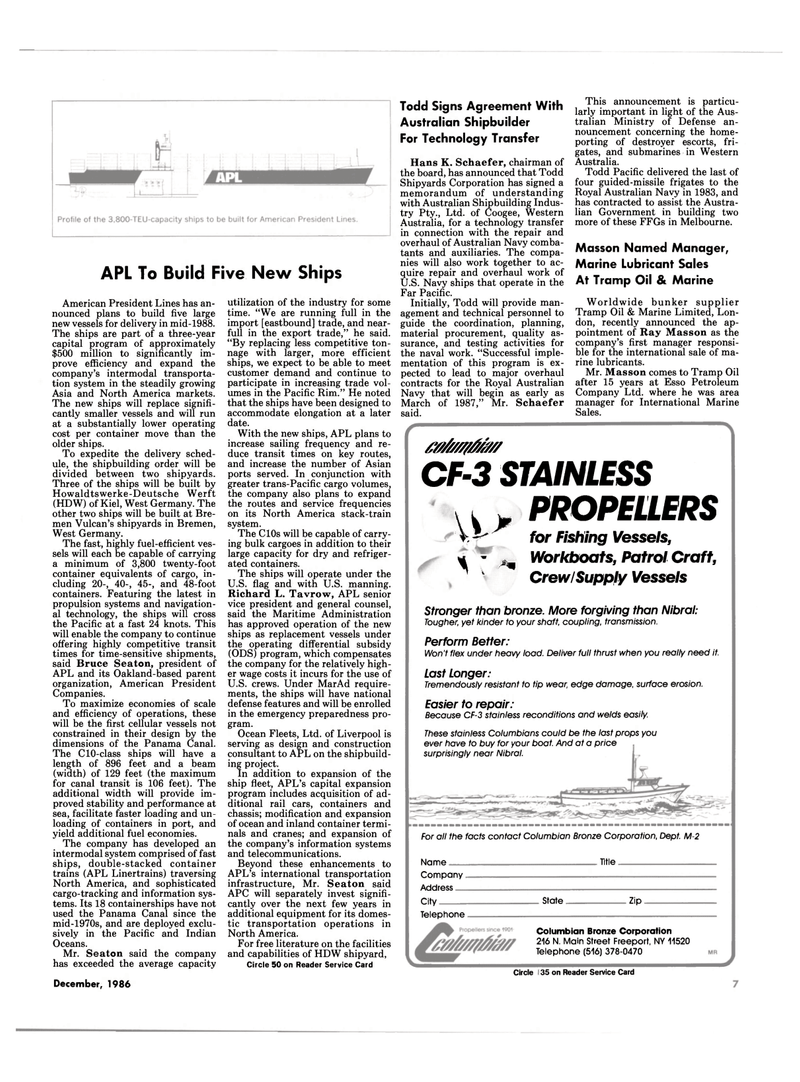
Page 5: of Maritime Reporter Magazine (December 1986)
Read this page in Pdf, Flash or Html5 edition of December 1986 Maritime Reporter Magazine
APL To Build Five New Ships
American President Lines has an- nounced plans to build five large new vessels for delivery in mid-1988.
The ships are part of a three-year capital program of approximately $500 million to significantly im- prove efficiency and expand the company's intermodal transporta- tion system in the steadily growing
Asia and North America markets.
The new ships will replace signifi- cantly smaller vessels and will run at a substantially lower operating cost per container move than the older ships.
To expedite the delivery sched- ule, the shipbuilding order will be divided between two shipyards.
Three of the ships will be built by
Howaldtswerke-Deutsche Werft (HDW) of Kiel, West Germany. The other two ships will be built at Bre- men Vulcan's shipyards in Bremen,
West Germany.
The fast, highly fuel-efficient ves- sels will each be capable of carrying a minimum of 3,800 twenty-foot container equivalents of cargo, in- cluding 20-, 40-, 45-, and 48-foot containers. Featuring the latest in propulsion systems and navigation- al technology, the ships will cross the Pacific at a fast 24 knots. This will enable the company to continue offering highly competitive transit times for time-sensitive shipments, said Bruce Seaton, president of
APL and its Oakland-based parent organization, American President
Companies.
To maximize economies of scale and efficiency of operations, these will be the first cellular vessels not constrained in their design by the dimensions of the Panama Canal.
The ClO-class ships will have a length of 896 feet and a beam (width) of 129 feet (the maximum for canal transit is 106 feet). The additional width will provide im- proved stability and performance at sea, facilitate faster loading and un- loading of containers in port, and yield additional fuel economies.
The company has developed an intermodal system comprised of fast ships, double-stacked container trains (APL Linertrains) traversing
North America, and sophisticated cargo-tracking and information sys- tems. Its 18 containerships have not used the Panama Canal since the mid-1970s, and are deployed exclu- sively in the Pacific and Indian
Oceans.
Mr. Seaton said the company has exceeded the average capacity
December, 1986 7 utilization of the industry for some time. "We are running full in the import [eastbound] trade, and near- full in the export trade," he said. "By replacing less competitive ton- nage with larger, more efficient ships, we expect to be able to meet customer demand and continue to participate in increasing trade vol- umes in the Pacific Rim." He noted that the ships have been designed to accommodate elongation at a later date.
With the new ships, APL plans to increase sailing frequency and re- duce transit times on key routes, and increase the number of Asian ports served. In conjunction with greater trans-Pacific cargo volumes, the company also plans to expand the routes and service frequencies on its North America stack-train system.
The ClOs will be capable of carry- ing bulk cargoes in addition to their large capacity for dry and refriger- ated containers.
The ships will operate under the
U.S. flag and with U.S. manning.
Richard L. Tavrow, APL senior vice president and general counsel, said the Maritime Administration has approved operation of the new ships as replacement vessels under the operating differential subsidy (ODS) program, which compensates the company for the relatively high- er wage costs it incurs for the use of
U.S. crews. Under MarAd require- ments, the ships will have national defense features and will be enrolled in the emergency preparedness pro- gram.
Ocean Fleets, Ltd. of Liverpool is serving as design and construction consultant to APL on the shipbuild- ing project.
In addition to expansion of the ship fleet, APL's capital expansion program includes acquisition of ad- ditional rail cars, containers and chassis; modification and expansion of ocean and inland container termi- nals and cranes; and expansion of the company's information systems and telecommunications.
Beyond these enhancements to
APL's international transportation infrastructure, Mr. Seaton said
APC will separately invest signifi- cantly over the next few years in additional equipment for its domes- tic transportation operations in
North America.
For free literature on the facilities and capabilities of HDW shipyard,
Circle 50 on Reader Service Card
Todd Signs Agreement With
Australian Shipbuilder
For Technology Transfer
Hans K. Schaefer, chairman of the board, has announced that Todd
Shipyards Corporation has signed a memorandum of understanding with Australian Shipbuilding Indus- try Pty., Ltd. of Coogee, Western
Australia, for a technology transfer in connection with the repair and overhaul of Australian Navy comba- tants and auxiliaries. The compa- nies will also work together to ac- quire repair and overhaul work of
U.S. Navy ships that operate in the
Far Pacific.
Initially, Todd will provide man- agement and technical personnel to guide the coordination, planning, material procurement, quality as- surance, and testing activities for the naval work. "Successful imple- mentation of this program is ex- pected to lead to major overhaul contracts for the Royal Australian
Navy that will begin as early as
March of 1987," Mr. Schaefer said.
This announcement is particu- larly important in light of the Aus- tralian Ministry of Defense an- nouncement concerning the home- porting of destroyer escorts, fri- gates, and submarines in Western
Australia.
Todd Pacific delivered the last of four guided-missile frigates to the
Royal Australian Navy in 1983, and has contracted to assist the Austra- lian Government in building two more of these FFGs in Melbourne.
Masson Named Manager,
Marine Lubricant Sales
At Tramp Oil & Marine
Worldwide bunker supplier
Tramp Oil & Marine Limited, Lon- don, recently announced the ap- pointment of Ray Masson as the company's first manager responsi- ble for the international sale of ma- rine lubricants.
Mr. Masson comes to Tramp Oil after 15 years at Esso Petroleum
Company Ltd. where he was area manager for International Marine
Sales.
M//MZ0?//
CF-3 STAINLESS yt> ^ 4
PROPELLERS for Fishing Vessels,
Workboats, Patrol Craft,
Crew/Supply Vessels
Stronger than bronze. More forgiving than Nibral:
Tougher, yet kinder to your shaft, coupling, transmission.
Perform Better:
Won't flex under heavy load. Deliver full thrust when you really need it.
Last Longer: Tremendously resistant to tip wear, edge damage, surface erosion.
Easier to repair:
Because CF-3 stainless reconditions and welds easily.
These stainless Columbians could be the last props you ever have to buy for your boat. And at a price surprisingly near Nibral.
For all the facts contact Columbian Bronze Corporation, Dept. M-2
Name
Company.
Address
City . Title.
State. Zip.
Telephone.
Columbian Bronze Corporation 216 N. Main Street Freeport, NY 11520
Telephone (516) 378-0470
Circle 345 on Reader Service Card

 4
4

 6
6
